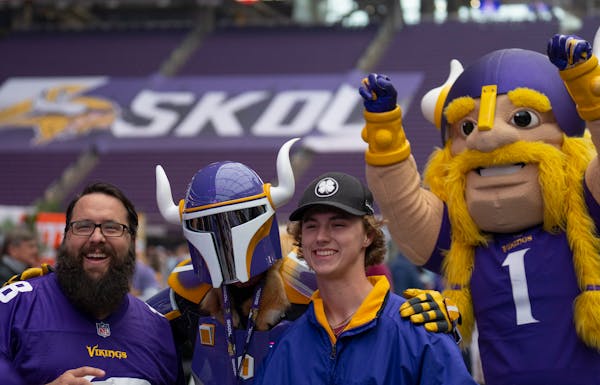The NFL was a tad more subdued in its salesmanship back on Jan. 20-21, 1950, when it drafted 391 players over 30 rounds from Philadelphia's Bellevue-Stratford Hotel.
"I was the 14th pick overall, and I didn't know it until someone called me later that night," said a fella named Bud Grant, one of three Gophers selected in that first round 72 years ago.
There was no television coverage of Bud's big day. No radio. No (fill-in-the-booze-sponsor) draft parties inside billion-dollar stadiums. No mock drafts. Heck, even Mel Kiper Jr. was 10 years from being born.
Bud, 94, was asked to compare that simpler era to Thursday night's Sin City production that joined together in a perfect storm of hullabaloo the draft's ever-burgeoning bravado and the Las Vegas Strip.
And, no, Bud didn't get all Grumpy Old Man.
"One of the joys of having lived this long is seeing how far we've come," he said. "It's good for TV. It's good for the fans."
It appeared to be especially enjoyable for Vikings fans emerging from a pandemic and looking for another NFL-sponsored excuse to drink beer at U.S. Bank Stadium. A few thousand of them already milling about before the draft started. They cheered Vikings tight end Irv Smith Jr.'s Skol clap and, yes, they gave a muffled Minnesota Nice boo to the Jumbotron when they spotted Commissioner Roger Goodell.
Bud likes this hype for another reason.
"It's good for the players," he said. "The money has gone from nothing to everything.
"I was Philadelphia's first-round pick, and their only offer was $7,500. No bonus. Take it or leave it. I left it."
Bud rejected the two-time defending NFL champs and returned to Minneapolis to play pro basketball for the Lakers. A season and a half later, he went back to Philly to negotiate again.
"I figured I had a better bargaining position," he said. "They said, 'OK, we'll give you $7,000.'"
Grant played two years in Philly, leading the team in sacks in 1951 and finishing second in the league in receiving yards in 1952. Then, having played out his team option year without re-signing, Bud bolted for the CFL and $10,000.
Bud's next experience with the NFL draft came on March 14-15, 1967, four days after he got the Vikings head coaching job.
Preparing for the draft was still a rudimentary process by today's standard. But the Vikings haven't had a better draft than 1967 when general manager Jim Finks was laid up in Fairview Southdale Hospital awaiting gallbladder surgery.
Finks was connected by phone to Grant and Jerry Reichow, a former player turned one-man personnel department.
"In '66, they called me in and said, 'We're going to make you personnel director,'" Reichow said. "I said, 'Great. But who do I direct?' We had no scouts except me. So it was me, Bud, Finks in the hospital, and Stubby Eason turning in the picks in New York."
Stubby was the team's equipment manager. He wrote down the names and handed them to Commissioner Pete Rozelle, who then wrote them on a chalkboard for the small media contingent. Sans TV, of course.
The Vikings ended up with three first-round picks that year because Finks traded Fran Tarkenton to the Giants and running back Tommy Mason to the Rams. They took running back Clint Jones second overall, receiver Gene Washington eighth and a guy named Alan Page 15th overall.
Grant admits to mostly observing that draft.
"The greatest thing about Bud was he didn't say anything," Reichow said. "But when he did, you better listen."
Bud remembers speaking up before the Page pick was made.
"Someone said, 'You know, no one has ever drafted three Black players in the first however many picks it was,'" Grant said. "I said, 'Well, I don't care.' I said, 'We're drafting the best players, right? Then I don't care what color they are.'"
That stellar draft also produced defensive back Bobby Bryant, one of the best late-round picks in team history. The seventh-rounder played 13 seasons, four Super Bowls, and finished with 51 interceptions.
"I was surprised when Stubby called me," Bryant said. "And happy. I got a $7,500 bonus. Bought a new Pontiac Bonneville for $3,500 and still had $3,500 left."
Bryant laughed when asked how much a 51-interception career would fetch in today's game.
"Ooh," he said. "It's so different now. Look at the draft. It's like a movie production. So I'm guessing 51 interceptions would be worth a whole lot more than $7,500 today."


